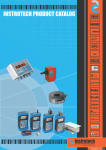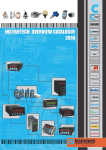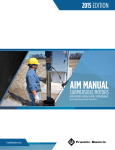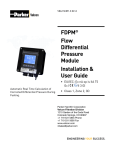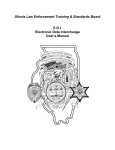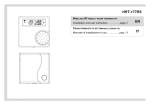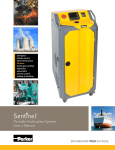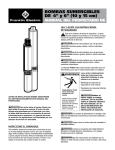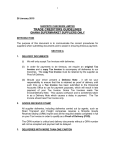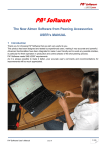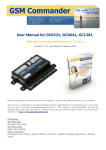Download MMS 1000-3 Transformer Moisture Management System
Transcript
EXPIOTECH (PTY) LTD MMS 1000-3 Transformer Moisture Management System User Manual MMS 1000-3 User Manual Expiotech (Pty) Ltd Unit 9 at 3 On London Cnr Rome Road and London Circle Brackengate Business Park Brackenfell 7560 South Africa Tel/fax: 0860 103335 e-mail: [email protected] www.expiotech.co.za i Table of Contents S Y S T E M O V E R V I EW 4 D E S C R I P T IO N 5 General, Electrical, Mechanical. P R O C E S S O V ER V I E W 6 General Monitoring the dry-out process I N S T AL L A TI ON 7 Connecting the MMS to the transformer Installing the filter cartridges into the MMS filter vessel S Y S T E M E V A C U A TI O N P R I M I NG T H E C H A NG IN G R E M O V AL S Y S T E M CA R T R I DG E S OF M M S 8 10 11 F R O M T R A N S FO R M E R 13 V A L V E 14 S CH E D UL E M A I N T E NA N C E 15 S P A R E S 17 F A UL T 17 F I ND IN G S E T T I N G U P T H E T R AI L ER 19 2 A P P E N D I C E S MMS 1000-3 Control System Manual Electrical Drawing Mechanical drawing Component manufacturers’ manuals 3 System Overview T he MMS 1000-3 series is designed to achieve a predetermined moisture level in a transformer’s insulation. Once connected to the transformer, it firstly measures the moisture in the insulation and then removes moisture, as required, from the insulation whilst the transformer remains in normal service. It achieves this by removing dissolved water from the insulating oil which, in turn, absorbs water from the paper insulation. The unit is PLC controlled and communication is via a web based monitoring and control system. The web based system allows full remote control of the unit, together with access to process data. System alarms are available via SMS or email. In “evaluation” mode, relative saturation and temperature data are logged. Software interprets these data and produces a report indicating the percentage moisture in the transformer insulation. In “filtration” mode, the filters are employed to remove moisture from the transformer. Process data are logged to produce reports indicating the amount of moisture removed from the transformer. The filter housing houses four Velcon SuperDri® type SD1107 filter cartridges designed to remove dissolved water from the transformer oil. The cartridges also have a nominal particulate removal capability of 1 micron. A pump with a nominal flow rate of 1800 litres per hour processes transformer oil through the filters. The filters do not remove dissolved gas, aromatics or oxidation inhibitors from the oil. For optimum filter efficiency, the transformer operating top oil temperature should be above 60° C during the dry-out process. This ensures moisture availability in the oil. Temperatures below 40° C normally require longer dry-out times. The accuracy of the moisture evaluation is also higher with higher top oil temperatures. The system is complete with all components necessary for its safe installation on an energized transformer and unattended operation. It is trailer mounted, suitable for towing on public roads. Note Alternative filter cartridges may be fitted to reduce the oil acidity level and dissolved compounds. Please contact Expiotech for more details. 4 Description Model: MMS 1000-3 Serial number: General The MMS components are housed in a 3CR12 stainless steel powder coated enclosure, with access via a door in the front of the unit for normal operation and via a hinged top cover for filter changes. Co-axial hoses connect the unit to the transformer. Solenoid valves, which disconnect the unit from the transformer when not in operation, are fitted at the remote end of the hoses. Motorised valves are also incorporated into the oil circuit to allow remote change over from evaluation to filtration mode. The unit is mounted on a stainless steel braked axle trailer with a GVM of 1600 kg. Electrical Power requirements: 220 volts single phase a.c. 5A 50 Hz. Supplied with 15 metre flexible power cable. Pump motor: EML 1,1kW, 1410rev/min, 230V. Flow meter: Hoffer Pressure switch: Wika Eco 1 Enclosure oil level switch: Anderson Solenoid valves: CS Fluid Power AD-20-V-G2-A-G 220 V Motorised valves: KLD Model 803 2 Nm 5.7 sec. 220 V Control system: Devcotech web based control system Moisture-in-Oil sensors: Elektronik EE36 5 Mechanical Pump: Pumptec model MISC/R21S-BSP pump, nominal 1800 l/h, internal bypass 4 bar. Pipework: 304stainless steel schedule 10 Hoses: 11 metre inlet, 14 metre outlet, coaxial. Filter vessel: Expiotech Sight glass: Primary Flowpoints Inlet Y strainer: 600 WOG 40 mesh Vacuum pump: PVR model EM4 Vacuum gauge: WIKA -100 to 500 kPa Trailer: Stainless steel, single braked axle with one front and two rear stabilizers, suitable for towing on public roads. Manufactured by Expiotech. 4 cu.m./h Process Overview T he transformer moisture measurement and dry-out processes are designed for safe continuous operation whilst the transformer remains in normal service. The MMS is connected to the transformer, ensuring compliance with High Voltage Operating regulations. After successful leak free installation and ensuring that the Buchholz gas valve is clear, the transformer can be returned to service during active filtration or evaluation. Oil from a bottom valve on the transformer is pumped through the unit and returned to the transformer through a top valve. In “evaluation” mode, the filters are by-passed. Data are downloaded normally over a period of about one week and the moisture level calculated. The moisture to be removed is determined. The MMS is then switched to “filtration” mode and the filters connected into the oil circuit. The process is remotely controlled and monitored. Once the desired amount of moisture has been removed from the transformer, the process may be stopped and the MMS moved to another transformer. 6 When saturated, the filter cartridges may be replaced and the process continued without affecting the transformer operation. The cartridges may remove up to 8 litres of water before saturation. The process time is determined by the initial water content of the transformer, its operating temperature profile during the process and the physical characteristics of the insulation. MONITORING THE DRY-OUT PROCESS. The MMS is fitted with a remote control system. Alarms, commands and process control are available. For example, the operator is alerted by an SMS &/or email that the cartridges are saturated and require replacing. Data from the whole process are available remotely during the process and indicate the total amount of water removed from the transformer, the moisture available and the temperature profile of the transformer. Switching from evaluation to filtration mode is carried out remotely. To compensate for a specific transformer’s oil saturation characteristics when calculating the Moisture Taken Out (MTO), an oil sample is taken from the transformer at the installation of the MMS and the Karl Fischer result in ppm is compared to the ppm reading on the inlet of the machine at the time of sampling. The ratio (>1.0) of the results gives the correction factor (CF) used in the (MTO) calculation. Several samples may be taken for a higher confidence level in the ratio. Alternatively, where the saturation characteristic constants are known, these may be entered. Inlet and outlet samples may be taken from sample valves V4 and V8. Installation CONNECTING THE MMS TO THE TRANSFORMER. Check that the transformer oil level is not abnormally low. The MMS will consume approx. 95 litres of oil from the transformer. Position the MMS unit next to the transformer, ideally in an oil catchment area, taking the transformer valves and power supply positions into consideration. Bond the MMS earth stud (adjacent to the trailer tow point) to the substation earth mat. Please consult a specialist to ensure the safety of personnel. Ensure that the oil inlet and outlet valves on the transformer are closed. Remove the blank flanges. Connect the MMS inlet hose (shorter green hose) to the transformer bottom valve i.e. oil is drawn from the transformer bottom into the MMS. 7 NB: The solenoid valves should be positioned preferably with the solenoid vertically upwards and no lower than horizontal. Connect the MMS outlet hose (longer yellow hose) to the transformer top valve i.e. oil is returned to the top of the transformer. NB: Returning oil to the transformer via the conservator drain pipe is not recommended due to the possibility of debris and/or free water being introduced into the transformer. Attach the magnetic temperature sensors to the transformer tank at the same height as the respective transformer valves, ensuring that both are influenced equally by external conditions (sun, shade, external heat source etc.). NB: It is important that the sensor connected to the connector marked yellow, at the rear of the cubicle, is attached to the top of the transformer and that marked green to the bottom of the transformer. The sensors are fragile and should be removed for transport. Connect the power supply to the MMS. INSTALLING THE FILTER CARTRIDGES INTO THE FILTER VESSEL. To install the four Velcon SD 1107 Superdri® cartridges into the filter vessel, unbolt and swing up the vessel lid. Unscrew the cartridge retainer and install the four cartridges. Screw down the retainer until snug. Close the vessel lid and tighten the eye bolts. System Evacuation Valve positions. 1. The transformer top and bottom valves should be closed. 2. The solenoid valves on the hoses are closed (pump not running). 3. Open the system inlet and outlet valves V1 and V2 Valves are “Closed” when the valve handle is at right angles to the centre line of the pipe and “Open” when the valve handle is in line with the pipe (See example below). 8 Valve open Valve closed 4. Open V6 and V7 vacuum line valves. 5. All remaining valves should be in the closed position. EVACUATING THE SYSTEM. 1. Switch the main switch on the control panel ON. The software takes several minutes to load. Once loaded, the PanelView goes to the main screen. . Press the bottom left corner of the screen if this does not occur. 2. Mode Select starts with standby mode button highlighted in green. 3. Select and press System Evacuation. The green Highlight moves from standby to System Evacuation. The green run light flashes. 4. Switch the vacuum pump switch ON. Press the green RUN button. All electro valves open and the vacuum pump starts. 9 5. Monitor the vacuum gauge. A minimum of -90 kPa should be achieved within 5 minutes. -100 kPa should be achieved within 10 minutes. If not, check for leaks (see page 17) and recheck all valve positions. 6. Continue to evacuate for a further 20 minutes during which the vacuum should be maintained. 7. When the evacuation process is complete, close valves V6 and V7. NB: It is critical that the valves are closed before the pump is switched off, otherwise the vacuum will be lost and the process will have to be repeated. 8. Press the stop button and switch the vacuum pump switch to OFF. NB: Never open the valve to the vacuum pump (V7) whilst the MMS is full of oil or the vacuum pump may be flooded with transformer oil. Priming the System Valve positions The valves should be in the following positions from the evacuation process: 1. The transformer top and bottom valves should be closed. 2. The solenoid valves on the hoses are closed (pump not running). 3. The system inlet and outlet valves V2 and V1 open. 4. V6 and V7 vacuum line valves closed. All remaining valves should be in the closed position. PRIMING THE SYSTEM. 1. In the Mode Select screen, select Process Priming Mode. Highlights change and the green start light flashes. 2. Open the transformer bottom valve. 3. Press the green start button. Oil will flow into the system. A timer will trip the pump every 60 seconds until oil flow is sensed at the system outlet. 10 4. Acknowledge the low flow alarm and restart the pump. Monitor the sight glass for oil flow. Repeat three times. (The system and hoses are now filled with oil). Acknowledge the low flow alarm each time.. 5. Crack open V5 and relieve the pressure in the filter vessel into a small container. Close V5. 6. Repeat steps 3. to 5. and verify that there are no signs at all of air being bled from the vessel. Press the red stop button. 7. Open the transformer top valve. 8. In the Mode Select screen, select Process Filtration or Process Evaluation Mode. The green start light flashes. Press the green start button. The MMS is now circulating oil through the transformer. NB: Ensure that there are no oil leaks from the transformer valves, hoses and MMS. Bleed the transformer Buchholz relay after at least 30 minutes operation to ascertain if any air has entered the transformer. This is highly unlikely. Check the transformer oil level. 9. The MMS can now be controlled and monitored remotely via the web site. Changing Cartridges When the cartridges are saturated, the system needs to be shut down for replacement cartridges to be installed. Press the red stop button. The MMS reverts to Standby Mode. Close the inlet and outlet valves V1 and V2. DRAINING THE VESSEL AND CHANGING THE CARTRIDGES. 1. Remove the plug at drain valve V3 and fit a hose barb and hose to drain approx. 20 litres of oil into a vessel. 2. Open valve V3 and vent valve V5. Close V3 after draining the oil. NB Do not drain the vessel completely. 11 3. Unbolt and open the vessel lid. Unscrew the cartridge retainer and remove the cartridges. Ensure that all filter cartridges have been removed (four). 4. Check that all gaskets are fitted to the new cartridges, especially the bottom one. Install the new cartridges, screw down the retainer until snug. Close and screw down the vessel lid. EVACUATING, PRIMIMG AND RESTARTING THE SYSTEM. Repeat the evacuation and priming processes described previously. 12 Removal of MMS from Transformer 1. Press the red stop button. The MMS reverts to Standby Mode. 2. Close the transformer top and bottom valves. Disconnect the hoses from the transformer valves and run out in a straight line on the ground. DRAINING THE SYSTEM. 1. Remove the plug and fit a hose at drain valve V3. This allows oil to be drained to waste into two 25 litre containers. 2. Open drain valve V3 and vent valve V5 and drain the oil into the containers. 3. Position the hose ends into suitable trays at ground level. 4. Select Manual Mode and open the electro valves EV1 to EV4. (press on desired valve on screen (valve is highlighted/bordered. The valve opens). After a default time, the valve will return to its normal state. However, to close it at any time, repeat the above Please note that valve state changes take approx. 5 seconds. 5. Lift and walk down the hoses from the machine to the trays to empty the hoses. Repeat as necessary. Note: This draining process is recommended to prepare the machine for the next installation and to avoid any oil spillage during transport. It is also recommended to remove the filter cartridges, especially if the machine is to be transported over poor road surfaces. 13 Valve Schedule V1 MMS oil inlet valve. V2 MMS oil outlet valve. V3 Drain valve for filter cartridge vessel. V4 Inlet sample valve. V5 Filter vessel vent valve. V6 Auxiliary vacuum line valve. V7 Vacuum pump valve. V8 Outlet sample valve. EV1 Inlet solenoid valve EV2 Outlet solenoid valve EV3 Motorised valve (bypass) EV4 Motorised valve (filter) These valves are installed on the ends of the inlet and outlet hoses. They are normally closed and open when the pump is switched on. They close automatically when the pump trips or is switched off. These valves change the machine mode from “evaluation” (filter vessel bypassed) to “filtration” (filter vessel in circuit). Transformer bottom valve This valve is part of the transformer. The MMS inlet hose is connected to this valve i.e. oil is drawn from the transformer through this valve. Transformer top valve This valve is part of the transformer. The MMS outlet hose is connected to this valve i.e. oil is returned to the transformer through this valve. 14 Maintenance The MMS requires very little maintenance. The following checks are required to ensure trouble free operation: - Before each use: 1. Check the inlet Y strainer for debris and clean as necessary. Example of a strainer being opened. 2. Check the hoses for damage. 3. Check the condition of the gaskets when connecting the hoses to the transformer valves. 4. Check the O ring seal on the filter vessel lid for signs of damage. In operation: 1. Check for oil leaks inside the enclosure and at the hose connections. 2. Check the operation of the enclosure and cubicle fans. 15 Annually: MMS Check the operation of safety devices: 1. Manual operation of the enclosure oil level switch should trip the pump. 2. Restricting flow to the pump (close V1 with the pump running) should cause the low flow switch to operate and trip the pump. 3. Closing valve V2 with the pump running should cause the pressure switch to operate and trip the pump. NOTE: Whenever the pump trips or is switched off, the solenoid valves on the hoses should close. Refer to the component/instrumentation manufacturers’ manuals for maintenance/calibration requirements on the various components and instruments in the MMS. These manuals are appended. Trailer The trailer should be checked and maintained by a qualified vehicle mechanic. 16 Spares Due to the simple operating principle of the MMS, very few spares are required. The following are recommended, to be kept at the MMS: 1. 2. 3. 1 x filter vessel O ring One set of filters (four filters per set) – Velcon Superdri® type SD 1107 2 x hose end flange gaskets Fault Finding The following first line fault finding checks should be followed is sequence until the fault is cleared. Where problems are still being experienced, contact Expiotech for assistance. Note: All electro valves may be operated independently when Manual Mode is selected in the Mode Select screen. MMS trips on “High pressure” - Check that the top valve on the transformer (outlet from MMS) is open. Check that the position of all valves on the MMS is according to the manual for the operation being carried out. Check that the solenoid valve on the outlet hose is opening when the pump runs. If all of the above are in order, replace the filters. Note: The filters will only cause a high pressure trip if they are blocked with particulate. Saturation due to moisture does not cause the filters to block. 17 MMS trips on “Low flow” - Check the inlet strainer for debris and clean if necessary. Check that the bottom valve on the transformer (inlet to MMS) is open. Check that the position of all valves on the MMS is according to the manual for the operation being carried out. Check that the solenoid valve on the inlet hose is opening when the pump runs. Remove pump and motor and test for flow rate. MMS trips on “Motor trip” - Check motor starter overload setting against motor rated current. On K1(motor contactor internal to panel), press reset. If re-trip occurs, see below. Remove pump and motor. Check pump and motor are not seized and operate freely. Test motor electrically. Evacuation – cannot achieve required vacuum - Check that valves V3, V4, V5 & V8 are closed Check that the filter vessel O ring is not damaged and is positioned correctly. Tighten down the vessel lid. Close valves in turn to isolate sections of pipework. Close vacuum line valve V7 and if vacuum is still not achieved immediately then a leak on pump is probable Check that the vacuum pump oil level is correct. Check vacuum pump hose end fittings are tight. Remove the vacuum pump for inspection. 18 Setting up the Trailer The trailer is a single axle (braked) type, with a maximum axle loading of 1600 kg. NB The trailer is designed to be towed at a speed not exceeding 100 km/h. When connecting to the towing vehicle, screw up the rear stabilizers to 10 cm above the ground. Raise the jockey wheel to a height that will allow the trailer to be lowered onto the tow bar without having to physically lift the trailer. The tow hitch can be then safely lowered onto the tow bar “ball” by winding down the jockey wheel. Ensure that the emergency brake cable is attached (If being towed by a vehicle without an attachment point, place the safety chain over the tow ball) and that the hitch is properly secured (i.e. ensure the safety latch is fully engaged). The jockey wheel can now be wound up fully and the carriage assembly raised until the jockey wheel sits snugly against the channel. (This is effected by rotating the carriage lock arm). Ensure that the rear stabilisers are fully retracted (screwed up position) before towing. Connect the 7-pin plug to the mating connector on the vehicle and check that all lights are operational before towing. When the trailer is uncoupled from the vehicle, store the 7-pin plug in the holder provided on the trailer. Refer to “Towing Check List” When parking the trailer, the jockey wheel must be deployed – before the trailer is unhitched from the towing vehicle. The trailer must be parked on a level surface (i.e do not attempt to unhitch the trailer on an incline). To deploy the jockey wheel, first wind the jockey wheel down by a few turns. Loosen the carriage lock arm and lower the jockey carriage fully. Tighten the carriage lock arm. Disengage the hitch safety lock and wind the jockey wheel until the tow hitch clears the ball of the towing vehicle. Lower the jockey wheel until the trailer tilts slightly towards the jockey wheel (only a few degrees). Manoeuver the trailer to the desired position whilst maintaining downward pressure on the jockey wheel. When in position, lower the rear stabilizers. (On soft ground, it may be advisable to lower them onto plates in order to distribute the weight). Adjust the rear stabilisers and jockey wheel so that the weight is equally distributed. Towing Check List 1. Ensure the trailer hitch is properly located. 19 2. Ensure that the emergency brake cable is attached (or safety chain located). 3. Ensure the 7-pin plug is connected to the vehicle socket. 4. Ensure the stabiliser legs are retracted and locked in position. 5. Ensure the system enclosure doors are closed and locked. 6. Ensure the spare wheel is located and locked. 7. Ensure that the hoses are properly secured. 8. Ensure that all valves are closed. 9. Check tyre pressures, including the spare. (Normally 375 kPa for normal road conditions). 10. Check operation of all trailer lights. Rev.1- 23.05.2013 DJWS 20





















